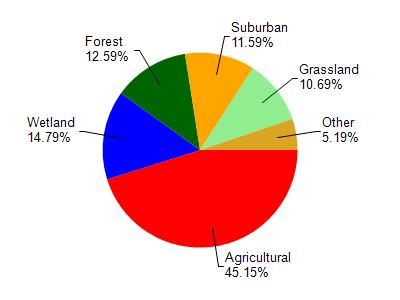Kenosha
No
No
No
Fish and Aquatic Life
Overview
This is landlocked warm water seepage lake whose basin has filled in with muck and silt. In glacial times it may have been connected to Bassett Creek and the Fox River, since there is a natural drainageway much higher than the present lake leading to the south. Soundings indicate that up to 20.0 ft. of silt and muck overlay a firm sand bottom. The lake's shallow depth and dense vegetative cover cause it to winterkill frequently making it difficult to establish a sport fishery. The shoreline is almost completely developed. An inland lake renewal district has been formed and a dredging project to deepen the lake was completed in 1979. If dredging objectives are fulfilled, a good sportfishery may be established. Past surveys indicated unstable populations of bullheads, perch, bluegills, largemouth bass, and northern pike. Muskrats are common and waterfowl are numerous, especially during migratory flights in spring and fall. Access is possible from a private livery and a town road with parking.
Source: 1982, Surface Water Resources of Kenosha County
Lilly Lake, (Leaone) TlN, R19E, Section 11, Surface Acres = 87, Maximum Depth = 6 ft, Secchi disc = 3.0 ft
Date 1982
Author Aquatic Biologist
General Condition
Lilly Lake (740900) was assessed during the 2016 listing cycle; total phosphorus and chlorophyll sample data were clearly below 2016 WisCALM listing thresholds for the Recreation use and Fish and Aquatic Life use. This water is meeting these designated uses and is not considered impaired.
Date 2015
Author Ashley Beranek
Condition
Wisconsin has over 84,000 miles of streams, 15,000 lakes and milllions of acres of wetlands. Assessing the condition of this vast amount of water is challenging. The state's water monitoring program uses a media-based, cross-program approach to analyze water condition. An updated monitoring strategy (2015-2020) is now available. Compliance with Clean Water Act fishable, swimmable standards are located in the Executive Summary of Water Condition in 2018. See also the 'monitoring and projects' tab.
Reports
Management Goals
Wisconsin's Water Quality Standards provide qualitative and quantitative goals for waters that are protective of Fishable, Swimmable conditions [Learn more]. Waters that do not meet water quality standards are considered impaired and restoration actions are planned and carried out until the water is once again fishable and swimmable
Management goals can include creation or implementation of a Total Maximum Daily Load analysis, a Nine Key Element Plan, or other restoration work, education and outreach and more. If specific recommendations exist for this water, they will be displayed below online.
Monitoring
Monitoring the condition of a river, stream, or lake includes gathering physical, chemical, biological, and habitat data. Comprehensive studies often gather all these parameters in great detail, while lighter assessment events will involve sampling physical, chemical and biological data such as macroinvertebrates. Aquatic macroinvertebrates and fish communities integrate watershed or catchment condition, providing great insight into overall ecosystem health. Chemical and habitat parameters tell researchers more about human induced problems including contaminated runoff, point source dischargers, or habitat issues that foster or limit the potential of aquatic communities to thrive in a given area. Wisconsin's Water Monitoring Strategy was recenty updated.
Grants and Management Projects
Monitoring Projects
| WBIC | Official Waterbody Name | Station ID | Station Name | Earliest Fieldwork Date | Latest Fieldwork Date | View Station | View Data |
|---|
| 740900 | Lilly Lake | 303126 | Lilly Lake - Deep Hole | 2/3/1978 | 6/22/2025 | Map | Data |
| 740900 | Lilly Lake | 10056144 | Lilly Lake - Application Area A-22 | 5/23/2022 | 5/30/2022 | Map | Data |
| 740900 | Lilly Lake | 10056146 | Lilly Lake - Application Area C-22 | 5/23/2022 | 5/30/2022 | Map | Data |
| 740900 | Lilly Lake | 10001323 | Lilly Lake | 6/1/1989 | 9/15/2017 | Map | Data |
| 740900 | Lilly Lake | 10017528 | Lilly Lake -- Access Off Lilly Lake Rd | 4/6/1989 | 9/2/2021 | Map | Data |
|

Watershed Characteristics
Lilly Lake is located in the Lower Fox River - Illinois watershed which is 114.04 mi². Land use in the watershed is primarily agricultural (45.20%), wetland (14.80%) and a mix of forest (12.60%) and other uses (27.50%). This watershed has 144.75 stream miles, 2,176.46 lake acres and 9,772.38 wetland acres.
Nonpoint Source Characteristics
This watershed is ranked Medium for runoff impacts on streams, Medium for runoff impacts on lakes and High for runoff impacts on groundwater and therefore has an overall rank of High. This value can be used in ranking the watershed or individual waterbodies for grant funding under state and county programs.This water is ranked High Lake for individual Lakes based on runoff problems and the likelihood of success from project implementation.